| Srl | Item |
| 1 |
ID:
131984
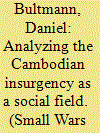

|
|
|
|
|
| Publication |
2014.
|
| Summary/Abstract |
This article investigates power practices in the Cambodian insurgency after 1979 as being part of a social field. There are various types of power practice being exercised by commanders aiming at making soldiers disciplined inside the insurgency. The hypothesis explaining these variations being proposed here is that the type of power being exercised depends on the habitus of the respective commander. Power practices are shaped by the incorporated classificatory discourse of commanders on good soldierhood and leadership. Thereby, armed groups can be analyzed as a social field in which practices are always relational and part of symbolic struggles between different commanders.
|
|
|
|
|
|
|
|
|
|
|
|
|
|
|
|
| 2 |
ID:
131978
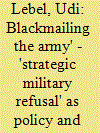

|
|
|
|
|
| Publication |
2014.
|
| Summary/Abstract |
The study shows how 'strategic military refusal' in Israel developed as a rational and institutional means to influence security policies. As opposed to the perspective that sees military refusal as a spontaneous individual act, the study illustrates how organizations operate to distribute military refusal in order to pressure decision-makers to change their military policies. This strategy has proven to be effective when the military is involved with groups that threaten it with refusal - which threatens the military's operational ability and its official and apolitical image. These include soldiers whose civilian authorities, rather than their military commanders, are perceived as an epistemic authority regarding security issues. The case study refers to the impact of strategic military refusal in Israel on security policies and the military doctrine. This was influenced by leftist groups, which, although they belonged to the parliamentary opposition, had dominant presence in the military ranks. Furthermore, the study examines the effect of the use of strategic military refusal on the model of military recruitment.
|
|
|
|
|
|
|
|
|
|
|
|
|
|
|
|
| 3 |
ID:
099551


|
|
|
| 4 |
ID:
131466
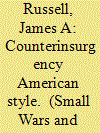

|
|
|
|
|
| Publication |
2014.
|
| Summary/Abstract |
This article examines the complex legacy of David Petraeus who was a key figure in the emergence of the US military shift towards counterinsurgency doctrine in the years after 2006. Although Petraeus has been perceived by critics as a publicity seeker, he can be credited with laying the foundations for a more serious commitment to COIN involving in particular in integrating conventional and Special Forces in arenas like village stability operations. The article looks a Petraeus's role in both Iraq and Afghanistan: it concludes that, in the case of Afghanistan, it is too early to assess whether counterinsurgency has had a decisive impact of the outcome of the war against the Taliban.
|
|
|
|
|
|
|
|
|
|
|
|
|
|
|
|
| 5 |
ID:
131465
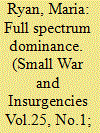

|
|
|
|
|
| Publication |
2014.
|
| Summary/Abstract |
This article examines the evolution of US irregular warfare (IW) doctrine and practice from 2001 onwards. It argues that, after 9/11, top-tier civilian policymakers in the US Department of Defense (DoD) and across the US government developed a heightened awareness of asymmetric threats and non-conventional forms of warfare, especially those shaped by contemporary globalisation. The result was a gradual turn towards irregular warfare, led by Rumsfeld and the DoD, designed to ensure 'full spectrum dominance' across all modes of conflict. This pre-dated the insurgency in Iraq and the promotion of counterinsurgency in the US Army by General David Petraeus and others. Policymakers' reluctance to acknowledge the insurgency in Iraq was not down to a failure to understand the concept of IW, but because they had viewed Iraq in conventional terms for so many years and were reluctant to admit their mistake.
|
|
|
|
|
|
|
|
|
|
|
|
|
|
|
|
| 6 |
ID:
131464
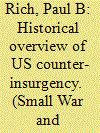

|
|
|
|
|
| Publication |
2014.
|
| Summary/Abstract |
This introductory article introduces some of the articles in this issue and examines the debate surrounding the idea of the "COINdinistas" in the US. It traces the roots of their approach to counter-insurgency and distinguishes "small c" counterinsurgency based on small groups of military advisers in "peripheral" conflicts from "big C" counter-insurgency which became allied to modernisation theory and nation building. The article also looks at developments in COIN thinking after the drawdown of US and other ISAF forces from Afghanistan, especially the work of David Kilcullen focussed on the emergence of future mega "feral" cities on coast lines vulnerable to terrorist and insurgent attacks
|
|
|
|
|
|
|
|
|
|
|
|
|
|
|
|
| 7 |
ID:
131340
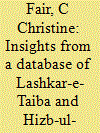

|
|
|
|
|
| Publication |
2014.
|
| Summary/Abstract |
This article uses a novel database of 1,625 posthumously published biographies of members of two Islamist militant organizations (Lashkar-e-Taiba (LeT) and Hizb-ul-Mujahideen (HM)), all of whom were killed in the course of carrying out militant attacks. In general, each biography provides data on the militant's birthplace, education, recruitment, and training. The number of observations in this database is a full order of magnitude larger than those of previous databases assembled from militant biographies. While the sample of militants in this database is the product of multiple selection effects, analysis of the database undermines many common myths about Pakistani militants and casts doubt on current policy approaches to mitigating Islamist militancy in Pakistan.
|
|
|
|
|
|
|
|
|
|
|
|
|
|
|
|